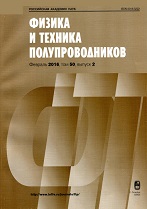|
|
Fizika i Tekhnika Poluprovodnikov, 2018, Volume 52, Issue 4, Page 483
(Mi phts5879)
|
 |
|
 |
This article is cited in 7 scientific papers (total in 7 papers)
XXV International Symposium ''Nanostructures: Physics and Technology'', Saint Petersburg, June 26-30, 2017
Quantum wells, Quantum wires, Quantum dots, band structure
Floquet engineering of gapped 2D materials
O. V. Kibisa, K. Dinib, I. V. Iorshc, I. A. Shelykhbc
a Department of Applied and Theoretical Physics, Novosibirsk State Technical University, 630073 Novosibirsk, Russia
b Science Institute, University of Iceland, Dunhagi 3, IS-107, Reykjavik, Iceland
c ITMO University, 197101 St. Petersburg, Russia
Abstract:
It is demonstrated theoretically that the interaction of gapped 2D materials (gapped graphene and transition metal dichalchogenide monolayers) with a strong high-frequency electromagnetic field (dressing field) crucially changes the band structure of the materials. As a consequence, the renormalized band structure of the materials drastically depends on the field polarization. Particularly, a linearly polarized dressing field always decreases band gaps, whereas a circularly polarized field breaks the equivalence of band valleys in different points of the Brillouin zone and can both increase and decrease corresponding band gaps. It is shown also that a dressing field can turn both the band gaps and the spin splitting of the bands into zero. As a result, the dressing field can serve as an effective tool to control spin and valley properties of the materials in various optoelectronic applications.
Citation:
O. V. Kibis, K. Dini, I. V. Iorsh, I. A. Shelykh, “Floquet engineering of gapped 2D materials”, Fizika i Tekhnika Poluprovodnikov, 52:4 (2018), 483; Semiconductors, 52:4 (2018), 523–525
Linking options:
https://www.mathnet.ru/eng/phts5879 https://www.mathnet.ru/eng/phts/v52/i4/p483
|


| Statistics & downloads: |
| Abstract page: | 43 | | Full-text PDF : | 10 |
|





 Contact us:
Contact us: Terms of Use
Terms of Use
 Registration to the website
Registration to the website Logotypes
Logotypes








 Citation in format
Citation in format 
